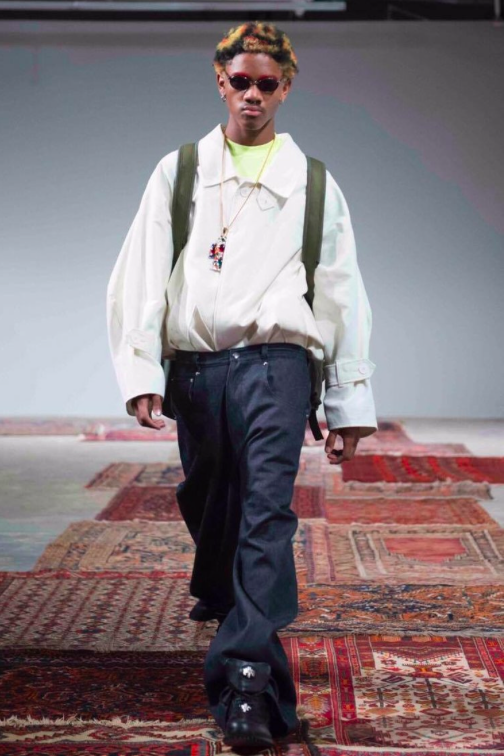BRI SCALESSE: “I’ve spent most of my life adapting clothing to work for my body. Pants never come up high enough in the back. Full skirts and dresses become entangled in my wheels. Long blazers, coats and sleeves get covered in dirt marks from dragging. I’ve found the styles that work for my body, but I often feel frustrated with the limited options. This project allowed me to wear clothes I could only dream of. It showed that a full skirt or dress is possible, as long as it is not full all the way around. An oversized blazer can work for a wheelchair user if it is tailored and designed around the wheels. The designers directly tackled the hard stuff and the results are amazing.”
Embodying Universal Bodies: Disability
A new first-year project on the Parsons MFA course tackles societal issues and seeks positive change through fashion design
Now in its ninth year, MFA Fashion Design & Society at Parsons is a leading course for emerging designers, helmed by fashion stalwarts Shelley Fox and Joffrey Moolhuizen (JOFF). This year, the first-year students took on a new challenge, intended to push the progressive, multidisciplinary approach of the course further. ‘Embodying Universal Bodies’ put a new spin on the ‘Personal Identity’ project that normally sees students examining their own place in the world. You can read about the motivation and meaning behind the project here.
The class of 17 was divided into four groups, addressing the ageing, transgender, plus size and disabled communities. They then had to find a muse from their given community, and work with them to fill the voids left by other fashion designers’ privileges. This is what went down in the Disability group.
The muse: Bri Scalesse (she/her)
The design team: Madison Hislop, Kyoung Eun Kim, Justin Hsiung, Kenneth Pan, Zoe Whelan
BRI SCALESSE: “It sounds simple, but making clothing for someone’s body type can literally validate their place in the world. Making adaptive design should not just be about making the garments easier for a wheelchair user, but instead about making a wheelchair user feel good and sexy and strong. Many adaptable brands are focused purely on function but there has to be a balance of both. Fashion is about innovation and design and that means constant evolution. It’s time for marginalised bodies to be part of that evolution.”
KENNETH PAN: “Fashion has celebrated a singular and ableist approach to design for so long. To dismantle ableism, we need to center the people we are designing for and respond to the specificity of their experiences. The industry has relied on a static and standing body with standardised proportions and expectations of how a body functions. Working with Bri, we took measurements that we wouldn’t normally consider, so we could account for her movements and her wheelchair. Bri named her wheelchair Aphrodite (or Aph for short) and sees it as an extension of her body.”
MADISON HISLOP: “As Bri uses a wheelchair we really had to explore the process of donning and doffing clothes in a way I had not considered before. It was really interesting to study the movement and restraints of garments, not just when they are on the body, but also in the process of dressing. This made me reconsider what functionality can mean when designing for a seated body and how important fit and fabric is to creating comfortable and enticing garments. More than anything I learnt the importance of asking questions. The conversation we had with designer Lucy Jones (of FFORA) were vital to help understand the complicated intricacies of designing for disability.”
KYOUNG EUN KIM: “We quickly realised that designing for disability is much more sophisticated and broad than we expected, so we agreed to focus on wheelchair users or ‘sitting bodies’ in design. I’ve learnt that no element of any garment design exists for the garment composition itself: it’s all there for the user.”
JUSTIN HSIUNG: “This project was incredibly challenging because it removed a totally self-indulgent approach from the start by decentering a physique that’s been standardised by agencies. It is important to recognise how mass production has erased customised fit and authentic experiences.”
ZOE WHALEN: “The western world spends most of its time seated in the office, at school or in transit. Despite that we design our garments to look and function their best when we are standing up. There are no pattern blocks or mannequins for a seated body, and hardly any guidelines for where to start and what to consider when creating a garment that functions best in a seated position. This is the only position that matters for wheelchair users, and one that we all could consider more based on our lifestyle. I feel incredibly grateful for having Bri as a friend and model and the patience she had while our fashion bubble crumbled around us. Love you Bri.”










































